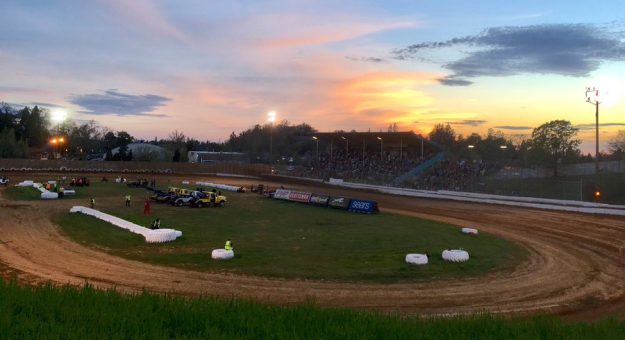On a cold November night, Scott Russell had a problem that any promoter would like to avoid. As the temperatures got lower, the line of shivering customers from the pits got longer, all looking for a cup of warmth. It was not a good night to run out of coffee.
On a cold November night, Scott Russell had a problem that any promoter would like to avoid. As the temperatures got lower, the line of shivering customers from the pits got longer, all looking for a cup of warmth. It was not a good night to run out of coffee.
“We‘ll have more in just a bit,” said the staff earnestly, as the line of customers got longer, colder and grumpier. “We just need to have more sent up from the grandstand side.”
A couple of customers closest to the window were lucky. They were holding empty Styrofoam cups like lottery tickets, a sign they were in line to get the dregs of the last pot.
But Russell could sweat temporarily running out of coffee. After all, over the last few years, the Placerville Speedway promoter had already survived fire and pestilence. Running out of coffee was a sign, things were looking up.

On this night, the finale of the Hangtown 100 for the USAC midgets, he had thousands of extra reasons to run out of coffee. It was the biggest crowd in the 57-year history of the quarter-mile oval in the Sierra foothills.
It would be easy to chalk up the size of the crowd to the quality of the show. After all, the nation‘s best midget drivers only come to the West Coast once a year. Still, it took courage to put on a race with $100,000 on the line, especially in late November, when the mountain air in Gold Rush country reminds one that it‘s winter even in California.
But the biggest reason for the crowd size was the sweat Russell had invested over the previous weeks to make room for all the extra fans.
“I just ripped out 250 feet of fence and the new one is 15 feet tall across turns and three and four,” said Russell as he stood in the shadow of a new grandstand. “My family owns a dump truck and I used it to haul 30 loads of rock and spread it myself and then I added 1,600 seats behind it.”
The enterprising Russell, who worked for a drilling company and around heavy construction equipment in his pre-promoter days, estimates the fence would have been five times more expensive if he had hired someone to do the work.
Beyond making the pit area safer, the new fence was just one of many re-building projects Russell had in mind. Getting it done was a testament to the resilience of Scott and his partner, Kami Arnold, to rebound from setbacks over the last two years and stretch budget dollars like taffy to keep their improvement plans on schedule.

In the weeks leading up to the USAC event, Placerville Speedway was taken over — figurately — by a fire. The track and pit area, which sits on the El Dorado County Fairgrounds, was confiscated by firefighters as a staging area while they fought one of the biggest wildfires in California history. The Caldor Fire churned through the adjacent Tahoe National Forest, charring 221,835 acres and threatening the resort town of South Lake Tahoe, while flames came within 20 miles of the track.
State fire officials took command of the Caldor fire on a Wednesday in mid-August. Within 24 hours the pit area was full of bulldozers, crew trucks and other heavy fire-fighting equipment. The infield, more accustomed to staging 360 sprint cars for qualifying, was filled with three dozen large tents housing state and county firefighters on their rest days.
They hoped to have the fire contained by the end of the month and Russell hoped he could salvage the rest of the season. Instead, the crews stayed for nine weeks, until late October, just a month before the big USAC race and iffy, winter weather. Indirectly, the fire had burned through Placerville‘s last track points championship race and a Saturday night World of Outlaws race that would have drawn a large crowd.
“That stung a bit, but considering what the fairgrounds were being used for, that was most important,” said Russell. “We thought we were going to struggle in 2021 and that it would take two or three years to recover from the year before, but crowds for our weekly shows were bigger than they had been in other years,” Russell said, believing “people were looking for normalcy” after being isolated by the pandemic.
Undaunted by the disruption, Russell worked to make the best of a bad situation. Hired by the firefighters to keep the dust down, Russell ran to his water truck.
“I‘ve been driving the water truck 12 hours a day, so we‘ve been able to recover some of what we lost,” Russell recalled. “I made money with the water truck and I‘ve spent more than that, but there isn‘t any part of this property that I haven‘t touched. Even if I don‘t stay past my contract, I‘ll leave it better than I found it.”
But there is no indication that Russell is going anywhere soon. A recent contract extension with fairground‘s management ensures that. As the season began, Arnold was still managing tickets, concessions and business on the fan side of the house and Russell was still moving dirt on the pit-side. A new retaining wall was under construction not far from a recently completed restroom.
